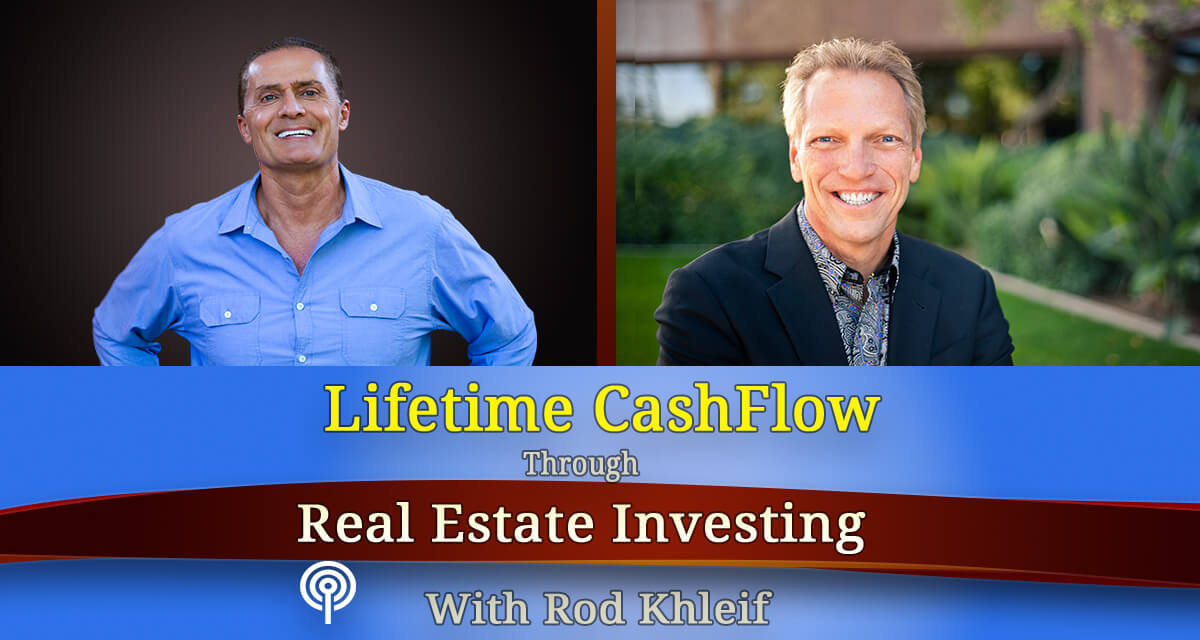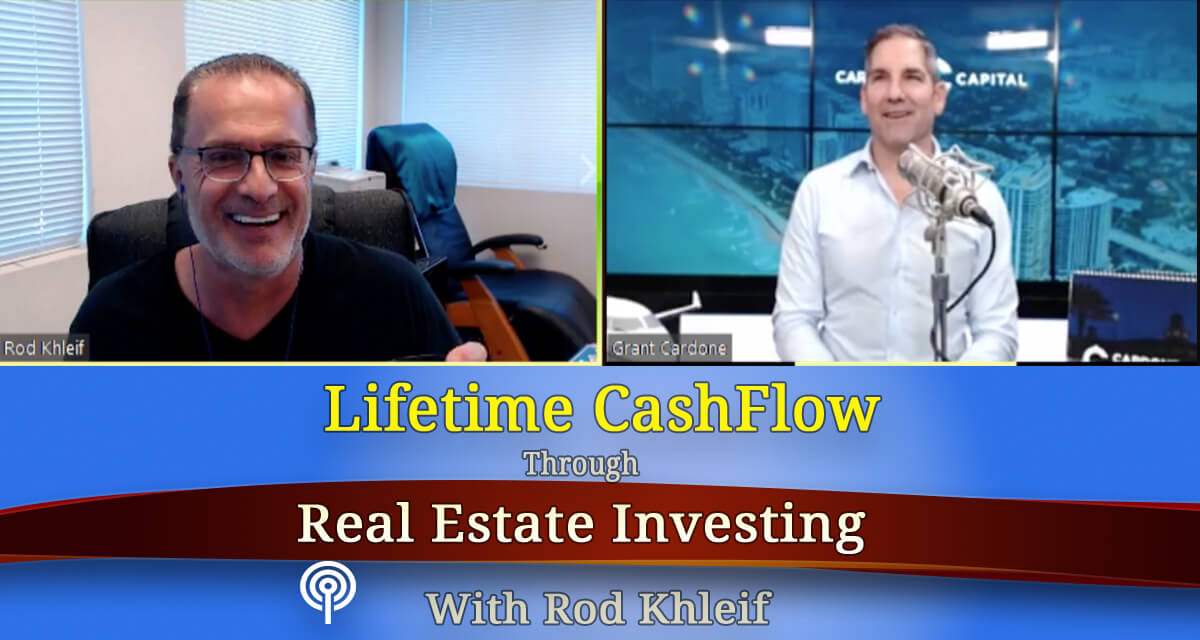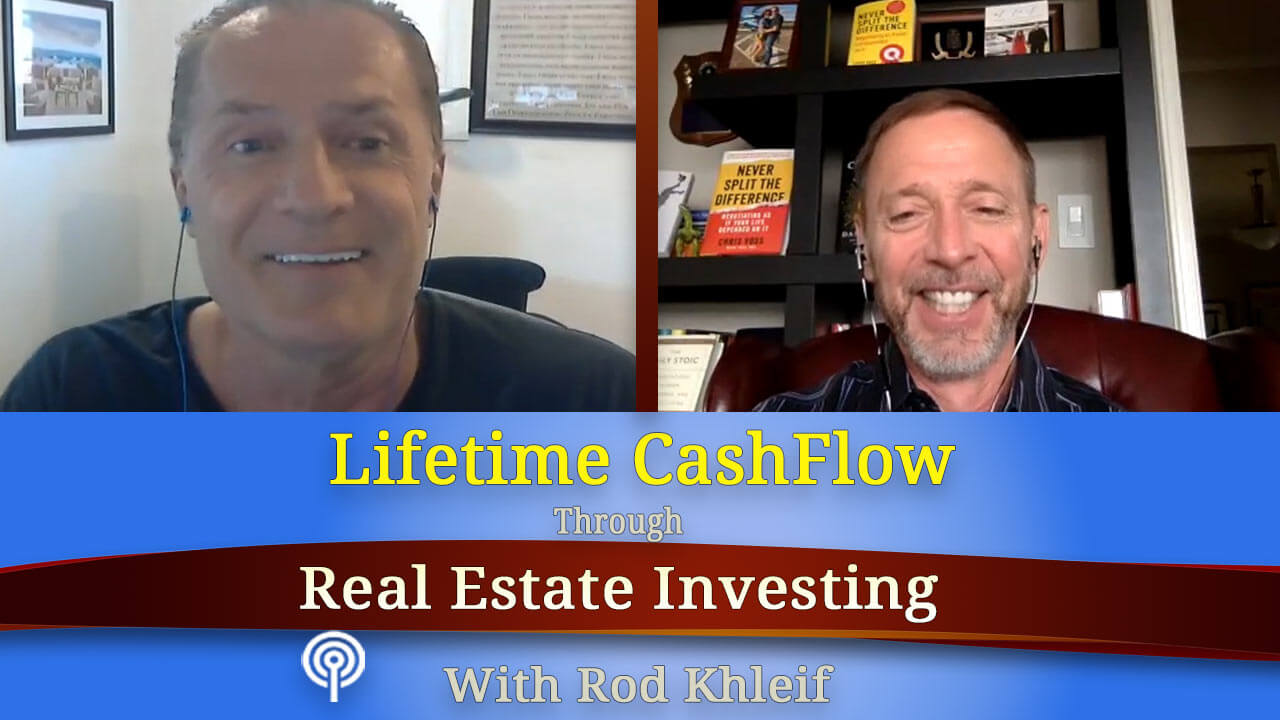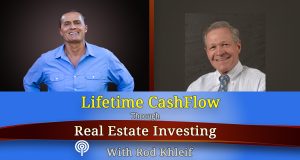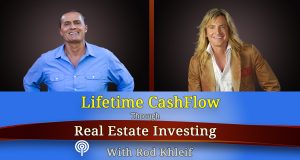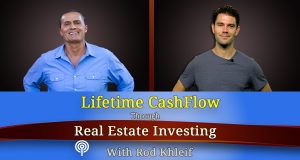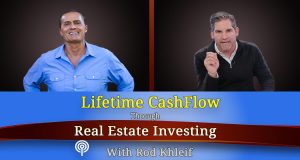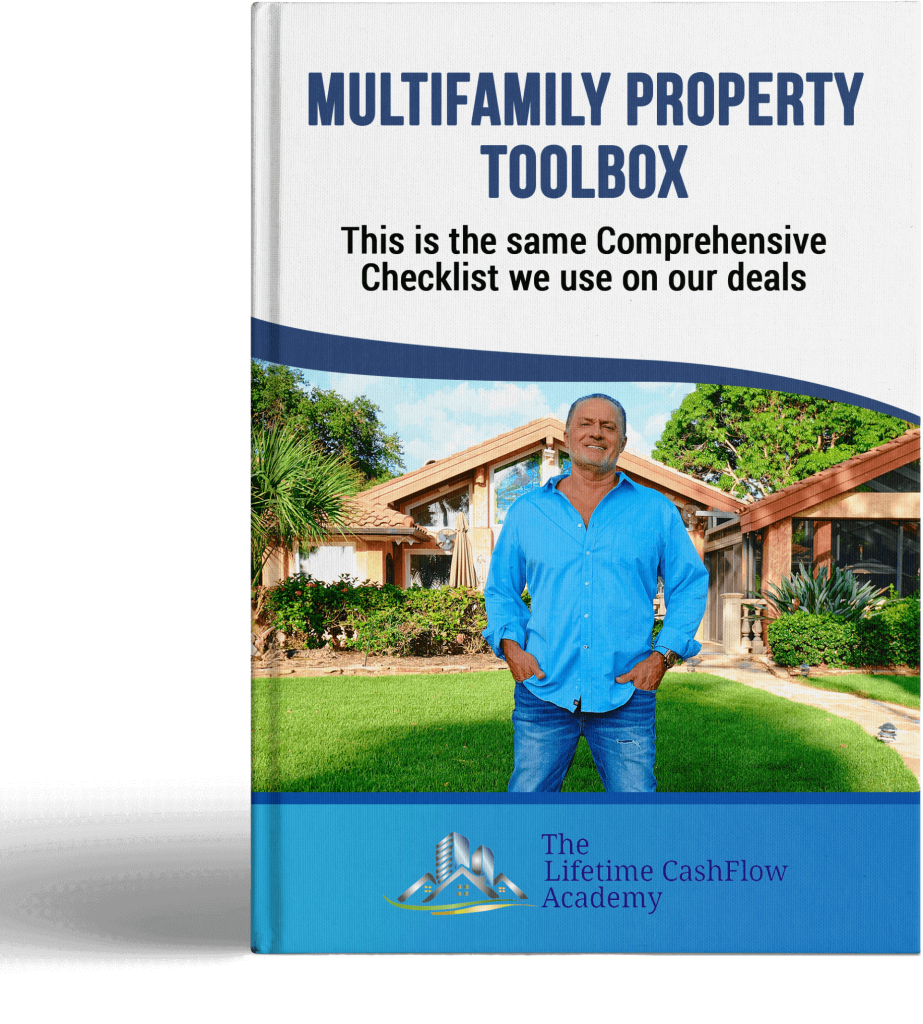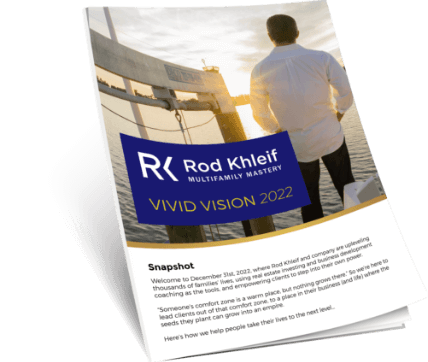Founder, CEO and Chairman of Fairway America and Verivest. Seasoned real estate executive, Chief Investment Officer, and fund manager who started and managed eleven real estate asset based Reg D pooled investment funds over more than 22 years. Discretionary underwriter/approval authority of thousands of real estate asset based investments with total asset value in the billions, including pooled investment funds, real estate secured loans (newly originated and discounted acquisitions), syndications, participations, GP and LP equity interests, and more.
Here’s some of the topics we covered:
- Different Types of Syndications
- The Deals You Take Down Determine Your Deal Structure
- How To Influence an Investor Into Your Fund
- Passive Investing In Pooled Funds
To find out more about partnering or investing in a multifamily deal: Text Partner to 72345 or email Partner@RodKhleif.com
Please Review and Subscribe
Full Transcript Below
Intro
Hi. My name is Rod Khleif, and I’m the host of “The Lifetime Cash Flow Through Real Estate Investing” podcast. And every week, I interview Multifamily Rock Stars and we talk about how they’ve built incredible wealth for themselves and their families through multifamily properties. So hit the “Like” and “Subscribe” buttons to get notified every Monday when a new episode comes out. Let’s get to it.
Rod
Welcome to another edition of Lifetime Cash Flow Through Real Estate Investing. I’m Rod Khleif, and I am thrilled that you’re here. And you’re going to get tremendous value from the gentleman I’m interviewing today. His name is Matt Burk, and he’s the founder and CEO, and chairman of Fairway America and a company called Verivest. And he’s been– probably forgotten more about real estate and fund management and raising equity than most of us will ever know. So really want to put your listening caps on and maybe take some notes because it probably will get fairly detailed, but we’re going to have some fun today. Welcome to the show, Matt.
Matt
Thank you, Rod. Glad to be here.
Rod
Yeah, I’m glad you’re here. And it’s interesting, right before we start recording, we were just talking about, you know the fact that I’m setting up an opportunity fund right now, you know a distressed asset fund. And, you know, I mentioned that my team is talking to a law firm that we’ve done business with before to set that up, and you started to tell me, you know, what you do in an advisory role. So I want to circle back to that in a minute. But let’s start with having you just give a little background, a little better job on your bio than I did, obviously, and talk about some of the stuff you’ve done and then we’ll get into some questions.
Matt
Sure. Well, I’ll give you a quick overview to give listeners some context, but, you know I started as a private money lender and founded the company in 1992. So kind of came out of the residential lending space, started a mortgage brokerage shop, pretty quickly pivoted into doing private loans. Realized that I liked doing that a lot better than brokering home loans. Ended up matching kind of one commercial real estate hard money loan at a time with investors. Eventually started fractionalizing those and then at some point around ’99 decided there’s got to be a better way to do this. And so we embarked on doing our first pooled investment fund to make real estate loans. Launched that fund in ’99, 2000, made all the mistakes in the book, you know, learned a lot from it. Ended up doing you know fund 1, 2, 3, 4. Hit the downturn in the Great Recession, right? And then learned a lot of lessons about how to wind down a fund, you know what it was like to have leverage on that fund. And that first ten years were really just a learning experience on how to run and deal with all the issues surrounding a fund. And I come out of that Rod, in 2012 or so, I had a number of people coming to me saying, hey, Matt, I know you know quite a bit about funds, and I’m thinking about setting up a fund. What do you think about this and what do you think about that? What should I do here or there? And after the fourth or fifth one, I said you know, as we wind down this fund and come out of the Great Recession, there’s a lot of people out there that really would benefit from a lot of the things that we’ve learned. So we kind of launched an advisory practice and started doing advisory work for real estate– people who raise money from high net-worth investors who want to run a real estate fund of some sort, whether that’s a mortgage pool fund or a direct acquisition of real estate. We started doing work to help them structure that fund. Now, not the legal work, right? Because you need to get a lawyer, and they need to represent you on the securities work and all that, but the business structuring and how all the things interplay with one another because there’s– it’s not just the legal angle, right? You have the accounting angle, you have the origination angle, you have the capital raising angle, you have the asset management angle. And those– it all have to comport with each other. And so, we learned along the way. And since 2012, in the last ten years, I’ve probably done 250 or more advisory engagements for real estate people around the country to help them set up their own pooled investment fund. You know, we did that kind of as a strategy to meet a lot of people around the country that we could then invest in and alongside. And that’s what Fairway America has done over the last ten years, is really, you know, use that as an origination platform for us to find people to do deals with. And along the way, people started saying, hey, you know, I really need help doing the administration and figuring out how to do all the accounting and reporting in a pooled investment fund because it’s considerably more difficult than doing a single asset. And so we launched an advisory practice at Fairway back in 2014, which eventually grew to the point, Rod, that we split it off as a separate company. And that’s what ended up becoming what Verivest is today, which is a service provider that does a lot of that advisory setup and back-end administration work. So that’s a short version of a 30-year journey of, you know, being in the high net worth investor, you know, capital raising space for various real estate endeavors.
Rod
Yeah. Wow. Well, I know you also wrote a book called “Capital Attraction: The Small Balance Real Estate Entrepreneur’s Essential Guide to Raising Capital”. And I’m assuming that is– oh, no, that’s capital raising. Got it. Okay. All right, good. Yeah, so, you know as I said– and we talked about this, I talked about a competing company that I talked to about administrating the fund that we’re creating right now. And then I’m also talking to another portal that we’ve done business with before, kind of along the same lines. But let’s talk– if you don’t mind, let’s talk about some of the– and just so you guys know, I mean, he talked really fast and I know you’re used to talking about doing a syndication for a particular asset. We’ve never talked about a pooled investment fund, which means basically if your eyes are crossed from this, it just means you’re raising money for multiple investments basically, and not even necessarily all the same asset class, but that’s effectively it at a high level. But let’s talk about some of the nuances with setting up– because I think a lot of people are going to be setting up funds. I think there’s an opportunity coming, you know, certainly, and some of these operators have got bridge debt that are getting crushed into serious issues with having to take out financing or sell right now. And I think it’s going to get worse. And I don’t know if you agree but–
Matt
I think so, too.
Rod
Yeah, so there’ll be an opportunity in other words. And so I think, you know, there are a lot of large players thinking about doing funds right now. And again, I just mentioned to you I’ve got– I’m doing one myself. So talk about some of the nuances, pitfalls, you know, things to think about for the more sophisticated of you that are sitting here listening that thinking that you may want to do a fund.
Matt
Yeah, well, Rod, there’s a lot, for sure.
Rod
Right.
Matt
I think if I start at the high level, I think that people who have not run a fund before, I’ll use an analogy that I use frequently. It’s a bit like having kids for the first time, which people who’ve had kids can appreciate this. You know, you can babysit your niece and nephew and you can read parenting books and go to parenting classes and all that, but you really don’t know what it’s like to have kids until you’ve actually done it. Right? And then it’s a progression of having kids from infant to toddler, right, to you know, young person to preteen to teen. So there are different things that happen along the way. So, you know, I’d say what we try to do is help people understand what it’s going to be like as best as possible knowing that there’s no way to know for sure until you actually do it. So people have a lot of misconceptions about what it’s like. I’d say people tend to extrapolate what they know at the individual syndicated deal level to a fund and misunderstand–
Rod
So what are the differences? I’m sorry to interrupt. So what are the differences because I’ve got a lot of people on the show that have done you know, asset-specific syndications, myself included.
Matt
Yeah, well, in a fund, the money that comes into the fund is a combination– it’s a mutual fund, right?
Rod
Yeah.
Matt
It’s like having eight or ten stocks. So the performance of that fund is the performance of all the individual transactions, right? So the income and expenses that occur at the deal level all flow into an entity that is the fund. And then the fund has separate expenses associated with it, organizational costs, tax returns, you know, administration costs, management fees, et cetera, right, that impact those returns. So modeling out the performance of a fund when you have deals coming in at various points in time and investors coming in at various points in time is foreign to the way that people think about a syndication. So there’s a lot of things that you have to consider about how it works, that you can’t just take a syndicated, you know, spreadsheet, you know, and set of projections and then extrapolate it onto a fund and think that somehow that’s going to equate to what you’re going to be able to deliver in the fund.
Rod
So here’s a question, because one of the things that were proposed to us by a competitor was setting up a fund that’s kind of an evergreen fund, but it is asset specific, where it’s not pool– where the fund assets, at least this is my limited brain capacity understanding of it, is that the assets are really separated. But in this case, you don’t set up a new PPM every single time. Maybe you do a disclosure document. So you do an initial PPM, investors come in, but as each asset is brought in, it’s just a disclosure document. And I got the impression they could be separated. Is that a structure as well?
Matt
What you’re describing, I believe, is like a series LLC where you form a master LLC and then you form an individual. Yes, that can be done.
Rod
Okay.
Matt
It has its own nuances and challenges and limitations. And that’s the thing about it, Rod, is there is no perfect vehicle. They all have strengths, weaknesses, trade-offs that you have to make. And I’d say people generally, they don’t understand the trade-offs that they’re making, heading into it if you haven’t done it before. And ultimately that’s where I feel the value is.
Rod
Sure. And this is what you consult on is just the structures and the nuances and how to market it, how to facilitate it, how to, you know, handle the accounting, the posting and all that. And I know you’ve got a resource with your portal, the Verivest, to facilitate that.
Matt
And among other things Rod is it’s like, should it be open-ended, should it be closed-ended, you know?
Rod
Right.
Matt
And it varies depending on a person’s asset strategy. How broad or how narrow should the asset strategy be? You know, should you include both equity and debt in there?
Rod
Right.
Matt
If so, what are the accounting ramifications? How do you determine the share price that somebody’s paying for the acquisition of those units? Should you have debt and leverage at the fund level in addition to the asset level? Yes or no? I mean, a lot of that really boils down to what the entrepreneur is dealing, what kind of deals they’re dealing, drive and dictate the appropriate structure. And it’s very, very common that they mix that up, right? They create a structure that’s inappropriate for the type of assets that they’re dealing.
Rod
Really, interesting. Well, you know, of course, we’re talking multifamily value add for the most part in my audience. And I don’t know if that needs to be defined any differently than how I just defined it for what you just said. But, you know, I know one thing and those of you maybe listening, watching, thinking, yeah, maybe you’re newer and you’re getting into this business, don’t even think about doing a fund if you don’t have a track record.
Matt
No. Exactly.
Rod
You’re never going to raise money with a non-asset-specific fund. You have to start with deal-specific you know, syndications to get started and most likely have returned some money to go out there and do a fund so you can have a proven track record. Do you agree with what I just said?
Matt
I agree 100%.
Rod
Okay.
Matt
I’d say, people, if you don’t have a sufficient volume of deal transactions and you don’t have enough, you know, time and scars under your belt, you should absolutely not be thinking about doing a fund until you’ve done some number of syndications and your shop is sophisticated and experienced enough to be in a position where you actually want to embark on it. And we haven’t even talked about the differences between raising capital one deal at a time where the investors actually know which asset and what the economic characteristics are of that asset versus coming into a blind pool fund where they’re relying on the manager to make those judgments on their behalf and having no control over it whatsoever. So yes, I agree with you 100%.
Rod
Blind pool is much more difficult. Now, I mean, back to my comment about this other fund structure that was proposed to us, you know, recently, where it’s really just like an evergreen fund, and it’s like this like you said, a series, LLC series in a fashion where you just bring an asset in at a time and you’re actually marketing, you can actually market that asset where people can get their money in ahead of that, obviously. But does that strategy have merit? Does that sound like–
Matt
I would tell you that I have seen a very small handful of people run those successfully.
Rod
Why do you think that is?
Matt
I think it’s another layer of complexity that is difficult for most people to grasp and it becomes challenging to sell and to administer and to manage.
Rod
Interesting.
Matt
Versus just doing it on a limited– in a typical–
Rod
Asset specific.
Matt
Basis. Yeah.
Rod
Yeah.
Matt
I would say more often than not, Rod, I’d say either people are doing them on a syndicated one-at-a-time basis which people can scale you know, quite large, doing it that way and never go to a fund. Or you’re doing it done in a closed-ended fund basis where you have some number of deals in for a finite period of time, especially in multifamily value add. It’s almost certainly going to be a closed-ended for a, you know, call it a four to a five-year time frame and then another couple of year extension to be able to pay them back and so forth.
Rod
Okay.
Matt
And a lot of people run both funds and syndications, right? There’s nothing that says you have to do everything, you know, and [inaudible]
Rod
Right. Okay. If you don’t mind, talk to me about how you would influence an investor to invest in, say, one of these closed-ended funds because that’s probably more relative to my audience. A closed-ended fund where you’re going to do it for, like, you say, four or five years. So you’re able to, I don’t know, quasi-do a proforma in some fashion, I suppose.
Matt
Sure.
Rod
It’s still going to be very loosey-goosey because you don’t even know the assets yet. But can you speak to how you would market that kind of an entity?
Matt
Yeah. And I would say to use the word influence, I’d say my approach to investors will always be the same, which is to first understand what it is that they’re trying to achieve and accomplish. And only if it made sense that the fund was an appropriate vehicle for what they’re trying to do would I you know, go that direction. But fundamentally, the biggest difference between a fund and a single asset syndication is you get some diversification across multiple assets. So that if you happen to pick, you know, I mean, statistically speaking, right?
Rod
Right.
Matt
This is a broad generalization Rod, but, you know, if you do ten deals, you know, a few of them are going to maybe hit a home run. If we’re fortunate. A few of them are going to be some doubles, and one or two of them not going to work out so well.
Rod
Right.
Matt
You might even lose some money depending on market conditions and how you finance it and a variety of other things. If you happen to be in that one deal, it didn’t do so well, as an investor, right, you’re stuck in that one deal.
Rod
Right.
Matt
In a fund, you have the ability to spread it across multiple deals, you know, and theoretically get some diversification. A lot of that depends on, you know, how good is the manager. I mean, you know.
Rod
Sure. The operator. Yeah.
Matt
Yeah. So the operator is, in my mind, from an investor perspective, first and foremost, in a fund, you’re underwriting the operator. Right? You start there and you’re not looking so much at each individual deal. Obviously, you want somebody with a track record, but you don’t have any choice as the investor on what they’re going to invest in.
Rod
Right.
Matt
You need to know what their strategy is so that you have a big picture. Here’s, the box, the sandbox we’re going to play in. Right? But you don’t know which exact toy they’re going to, you know, purchase and bring in to use a bad analogy.
Rod
Yeah.
Matt
Yeah. Diversification is the biggest thing from an investor’s perspective.
Rod
Okay. Got to have some experience, got to have some seasoning. And so when you are consulting and counseling someone that’s doing a fund, what are some of the high-level target areas that you focus on in your practice to help them navigate the whole fund structure and the whole fund dynamic?
Matt
Yeah, I think I take a similar approach with clients as I would with investors, Rod, which is, you know, I ask a lot of questions first, right, to make sure I understand why they want to do a fund. And I would say more often than not, statistically, I would encourage people not to do it because I would say that the reasons they have for doing it are myths and misconceptions. Right?
Rod
Interesting.
Matt
So if I narrow it down to somebody who says, okay, and then depending on how they answer the questions, you know, then my objective is to steer them towards something that gives them the best chance of being successful. Right? Based on their combination of the kind of deals they do, the amount of money they need to raise, you know, the frequency and the velocity of those assets, what their investor base is historically, where they expect to raise the money from, right? And then coach and guide them to set something up that maximizes their chances of actually being successful with that fund. So that’s the approach that I take.
Rod
Okay, well, I think we’ll have a sidebar conversation about that. So the next question I have is what about a fund of funds where someone is building a fund to invest in someone else’s deal? Is that something that comes across your plate?
Matt
Oh, yeah. We’ve done a lot of that.
Rod
Okay.
Matt
And see a lot of people that get into real estate that want to be involved in passive investing that maybe don’t have the operational team or expertise, right, to be the ones that are managing the leasing and the construction and all that, but they’re good at raising money, right? I’d say in those instances you can create vehicles or entities that you use the capital to invest in specific operators and deals and then try to negotiate better terms, right, with that operator then the investor would be able to get if they were to go directly into that operator themselves.
Rod
Yes.
Matt
And we see a lot of those people and we have set up a lot of funds that do that.
Rod
Those of you listening, he did that kind of fast. I just want to explain just a little more detail what we just said. So, you know, if you feel like you can raise money and we’ve raised money on our deals in a situation like this, where somebody brought– perfect example, three million on our last deal. And so, you know, what that person did was raise that money. And then they brought it to our deal and they negotiated a little better return than the normal passive investors in that deal would have gotten. So they get– basically the spread, they make the difference. And it was a very good deal for this person that did it. That is a fantastic way, if you’re connected, for you to, you know, potentially get into this business. Now, you’re going to obviously want to align, evaluate, and really do your due diligence on who you’re going to– you know, the operator you’re going to do this with. But, you know, it’s a great strategy. And we’re actually thinking about helping some of our Warriors, some of my coaching students, you know actually implement that strategy right now. We’re actually thinking about that.
Matt
Yeah. Rod, that’s– we actually deal with a fair number of those kinds of folks and raise capital for some of our deals from people that do that.
Rod
Great.
Matt
So I agree with you 100%. For people who are good at– they have a network, they have a tribe, right, they have people that trust them, that they can raise the capital, but don’t necessarily want to get into the heavy lifting of actually doing the deals.
Rod
Right.
Matt
If you pick a good operator, that can be a great way to get into and do something like that.
Rod
Yeah, I love it. Well, listen, I definitely want to have a sidebar conversation with you about that because we’re literally implementing that right now with my student base. I’ve got, I don’t know, probably somewhere around 1300, 1400 one-on-one coaching students around the country that are killing it. So I want to talk about that. But, well, listen, I really appreciate you coming on the show, Matt. And again, guys, his book is “Capital Attraction: The Small Balance Real Estate Entrepreneur’s Essential Guide to Raising Capital”. His company, Verivest, sets up and facilitates funds for people. And again, he does consulting on this as well. Was there any question you wish I’d asked before we cut loose here because I know– too quickly?
Matt
No, you did a great job. There’s so much we could talk about. Right?
Rod
Right.
Matt
But a quick note on the, you know, fund builder is Verivest is about to launch a product that automates that process, Rod. So a lot of people who are getting started and want to set up an entity, you know, just complete automation where you can go from not having an entity to having the entity and be ready to raise very quickly.
Rod
Nice.
Matt
And so we’re trying to bring technology to that process.
Rod
Very cool.
Matt
We’ve done offline for years, so, you know, that’s something we got coming up that we’re excited about.
Rod
Very cool. Very cool. Well, listen, it’s very much a pleasure to meet you and I appreciate you coming on and sharing some wisdom today, my friend.
Matt
Yeah. Sounds good. And look forward to chatting with you offline.
Rod
Absolutely.
Matt
Thanks for having me.
Rod
Thank you.
Outro
Rod, I know a lot of our listeners are wanting to take their multifamily investing business to the next level. Now, I know you’ve been hard at work helping our Warrior students do just that using our “ACT” methodology which is Awareness, Close, and Transform. Can you explain to the listeners how they can get our help?
Rod
You bet. Guys, we’ve been going non-stop for three years building an amazing community of like-minded people. And our coaching students which we call our Warriors have had extraordinary results. They’ve purchased thousands and thousands of units and last year we did over 1,000 units with our students. And we’re looking to grow this group and take it to the next level. We’re looking for people who want to follow a proven framework that’s really step by step and then leverage our systems and network to raise equity, to find and close deals, and to build partnerships nationwide. Now, our Warrior community is finding success in any market cycle. So if you’re interested in finding out more about how you can become more of our incredible network and take advantage of the incredible opportunities that are coming very soon, apply to work with us at “MentorWithRod.com” or text “CRUSH” to “72345” and we’ll set up a call so you can check us out and we can check you out. That’s “MentorWithRod.com” or text “CRUSH” to “72345”.






